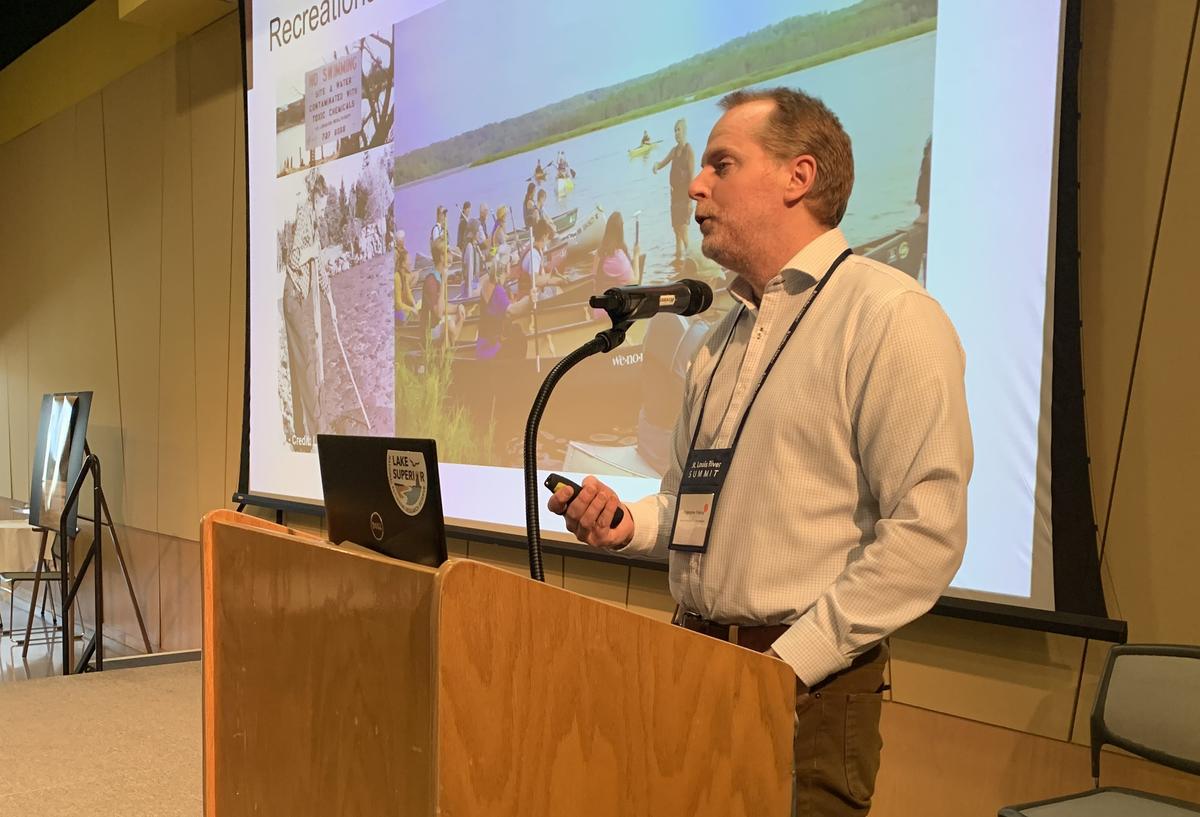Critical habitat for wildlife, cultural value to local indigenous communities and outdoor enthusiast attraction, the St. Louis River Estuary has a lot going for it.
But it also faces a lot of human-caused challenges, requiring some human support.
And the St. Louis River Summit brings it all together. Hosted by the Lake Superior National Estuarine Research Reserve on March 6 - 8, the Summit is a clearinghouse for scientists and community groups showcasing estuary research, sharing stories,even celebrating with artwork.
As they have since the Summit began in 2010, NRRI scientists will present research that addresses some of the challenges in, on and around the estuary. Here are some of the presentations showcased at this year’s event.
Back in Time
The industrial history of the river is captured in sedimentary layers that build over hundreds of years. Analyzing cores pulled from the bottom of the estuary, NRRI Aquatic Scientist Malachi Granmo uncovered the history of metals pollution in the estuary associated with natural factors and human-caused stressors. They were able to identify cadmium, lead, zinc, tin and other metals that reached a peak in the 1970s.
“Together with mercury, this group represents metals that are airborne and linked to fossil fuels and other industrial sources,” Granmo explained. “Our preliminary data indicate a complex combination of natural and human-caused variables to explain the changing metallic compositions in the estuary’s sedimentary record.”
Attracting People
As the estuary moves closer to being removed from the official “Area of Concern” list it’s sure to attract more recreational tourists. And that’s a good thing. But this active waterway has currents that are not as well understood as its adjacent Lake Superior rip currents. NRRI Limnologist Chris Filstrup will give a presentation about a forecasting model being developed to help people understand these dangerous currents to increase safety.

“Highly dynamic inflows from the St. Louis River and smaller tributaries combined with seiche effects from Lake Superior create complex circulation patterns in the estuary,” said Filstrup. “And yet, we have limited knowledge of the diverse types of drowning hazards in this area.”
This project will collect historical drowning data to identify high risk locations and scenarios, then develop a forecasting model to increase the lead time for community hazards in a free, online tool.
Toxic Algae
Despite water quality improvements beginning in the late 1970’s to the estuary, a recent increase in cyanobacteria blooms points to emerging environmental stressors. Graduate student researcher, Peter Birschbach will share research aimed at illuminating the extent and causes of several novel water quality concerns in the estuary, including algal community shifts, toxic cyanobacteria harmful algal blooms and hypoxia.
“In September and October last year, there were unprecedented blooms in the estuary, so this project investigates locations, timing and dominant bloom species to better understand what’s happening there and develop a long-term monitoring program,” said Birschbach.
The scientists are documenting the environmental conditions prior to, during and after blooms, along with evidence of cyanotoxin production.
Bird Habitat
The estuary flows between Minnesota and Wisconsin, and in the middle sits a unique island made of channel dredge material that is home to a regionally threatened bird species, the Common Tern, and lots of Ring-billed Gulls.
Interstate Island underwent a major restoration to improve the habitat, so NRRI Avian Researchers Annie Bracey and Steve Kolbe will present a summary of how this purposefully built space is used by birds.

“The primary goal of the habitat restoration was to maintain and increase the population of Common Terns breeding there,” said Bracey. “But we also documented how shorebirds and other species were using the newly restored habitat.”
The researchers documented 60 bird species using the island, including 10 species that are considered to be declining and six that are listed as common birds in steep decline. This project highlights the value of providing critical habitat in the St. Louis River for breeding and migratory birds and describes the value of building partnerships in the estuary to conserve biodiversity.
“This is a great example of how managing for a single species can benefit many other non-target species and how active management provides the opportunity to continually improve conditions to maximize the benefits of restoration into the future,” Bracey added.
Cultural Experience
It’s not hard to understand that a natural resource like the estuary benefits the lives of many people living in its proximity. But access is not necessarily equitable. A “Waterways Benefits Study” conducted by Molly Wick, a graduate student working at the Environmental Protection Agency and NRRI, identified a wide range of barriers to the cultural ecosystem services provided by the St. Louis River.
“Things like communication, governance and personal resources and privilege, don’t always reach all communities equally,” explained Wick. “So understanding these barriers can inform ways to mitigate those barriers for more people.”

Another project that reaches across cultural divides will be presented by NRRI researcher Tiffany Sprague and Minnesota Sea Grant’s Madison Rodman. They will showcase a community-centric demonstration of educating specific communities about green infrastructure. The “One Block” collaboration installed 20 rain barrels to residents’ homes in a marginalized St. Louis River community.
“By showing them where their rainwater flows and how rain barrels help water quality in their own neighborhoods, we can make a difference, one block at a time,” said Sprague. “Our goal is to broaden access to climate information, involve diverse groups in planning, and enhance environmental literacy on climate hazards and mitigation strategies.”
In addition, NRRI poster presentations include topics like protecting wild rice from rusty crayfish, improved analytical methods for measuring phosphorus concentrations and other projects to mitigate the impact of aquatic invasive species in the estuary.
PHOTO TOP: Chris Filstrup presents at the St. Louis River Summit on March 7.
